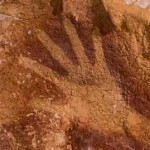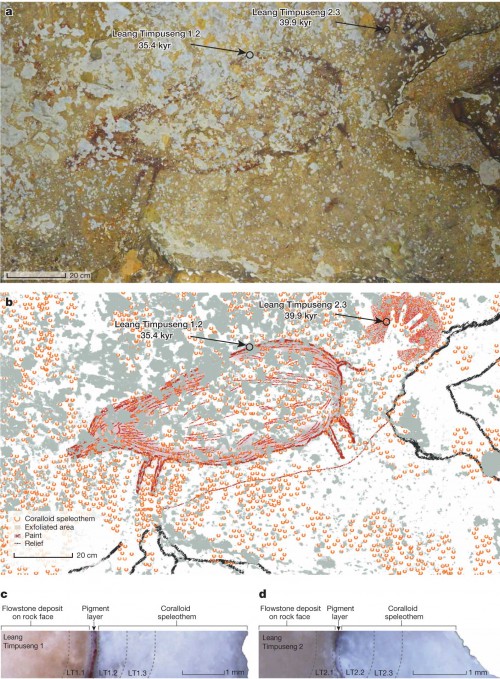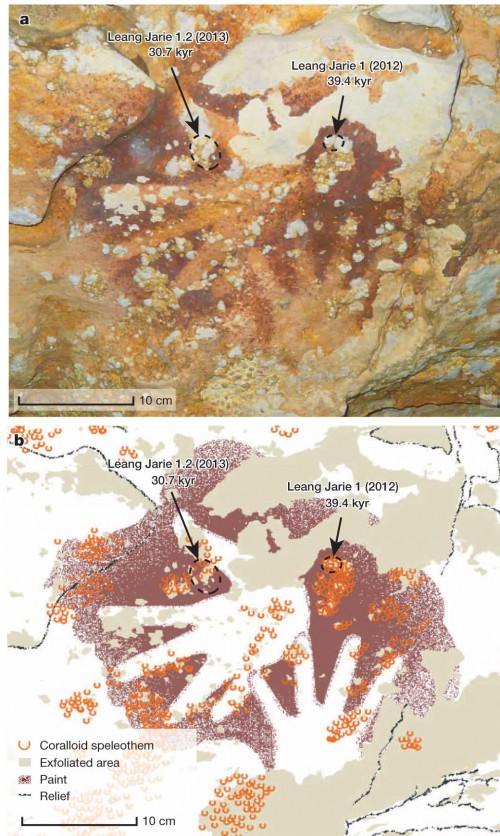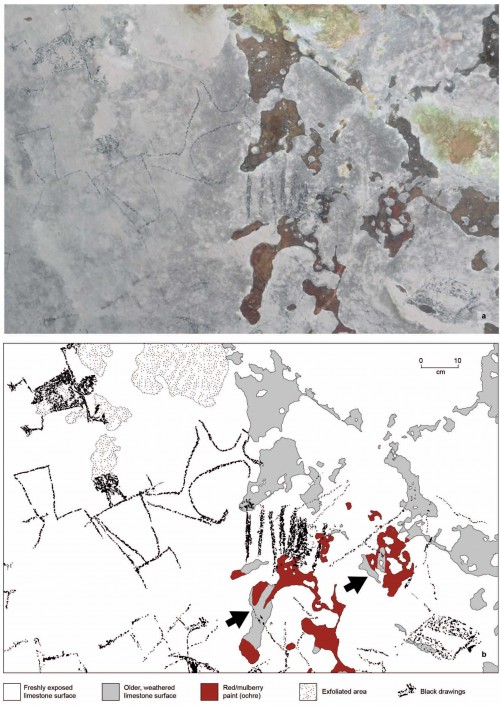What were our ancestors doing 40,000 years ago? Besides the necessaries of day-to-day living, they were making art, and some of it has survived to the present day. Every time I see one of these articles about cave art, I wonder about the rest of it, all lost: clothing, jewelry, paintings on more temporary media like hides and bark, dance and music. Those are all gone. All we have left, as fragile as they are, are a few scattered efforts preserved only by virtue of being put on rocks in deep and hidden places.
Even that is endangered. The European cave paintings are threatened by their revelation — exposure to outside air and the humidity from breathing viewers leads to a kind of creeping rot. These new paintings from Sulawesi, Indonesia are also in trouble. Many of them are marred by speleothems, secondary mineral deposits that form over the older layers, so they’re mottled and pitted and sometimes covered with sheets of obscuring material.
Those secondary deposits do provide one advantage, though: they can be dated, layer, by layer, so you can determine fairly precisely how old they were. The figure below shows at the bottom a cross section through these deposits, and you can see the base rock of the cave, the pigment layer where the painting was done, and overlying layers of speleothem. Some of these paintings are 40,000 years old, while the most recent are about 17,000 years old — so not only are they ancient, but they span 23,000 years of human activity.
The earliest paintings are often of local game, like the babirusa above, and most commonly, of human hands — just place your hand on the wall, and spray pigment around it to leave your mark. That’s an old, old impulse, and I think of the temptation of a freshly poured sidewalk, and how so often you’ll find a handprint pressed there. “I was here,” it’s saying. “Here I reach for a little more permanence.”
Here’s more. Just look at them.
What are you planning to leave, that will thrill people 40,000 years from now?
Aubert M, Brumm A, Ramli M, Sutikna T, Saptomo EW, Hakim B, Morwood MJ, van den Bergh GD, Kinsley L, Dosseto A (2014) Pleistocene cave art from Sulawesi, Indonesia. Nature. 2514(7521):223-7.







This finding is awesome. I was showing it to my kids this morning and made the comparisons to the hand art they make, turkeys and so forth, and the showing the shape of a hand is very personal. I then told them the impact of these caves paintings will last longer than anything the 3 of us will do in our lifetime. It puts things in perspective, that people had these impulses 40,000 years and probably longer ago.
Very interesting post. Thanks.
I cant help but wonder at the story behind that last hand print.
Did the maker fold under their two rightmost digits? If so, what is the sifgnificance of the gesture? Is it a hand signal used in their culture or just being a goof?
Did the maker, perhaps, lose the ends of those fingers in some sort of accident? If so, how? How did they treat the wounds so that infection didnt set in?
These kind of speculations are useless and unanswerable, but a lot of fun to ponder (for me, at least)
Imagine how proud some of those people would be to know that their images have outlasted every empire ever created.
Unfortunately, even as we’re discussing this discovery here, some idiot is out there making up silly reasons for why those works of art aren’t 40 thousand years old. Because their favourite religious claims otherwise, despite all the evidence it’s wrong..
At least, there isn’t an image of Jebus in there.
Countdown to : Creationists denying the age being 40,000; they’ll just wave it away, that scientists are just inflating the age (for CASH), that TRUE Science will reveal the TRUE age as 4,000. And If yuse want to know WHY those evil scientistas are lying, just send me some tax deductible CASH, right now…
I find those two hands amazing… were they made at the same time, or was one made later, taking care not to cover over the other? “I am here” … “and I am with you.” Or am I overthinking this? It kinda looks like the lower one might be the newer of the two, but the paint from that one has the older deposits over it… I dunnoes.
The hand in the top picture is pretty definitive proof of ancient aliens btw – Vulcans wuz ‘ere! :P
Umm… I once wrote a pair of poems about formatting C: and reinstalling windows?
I get tingles looking at cave paintings as if there is a haunting memory crackling behind my eyes wishing to gain remembering, but today I had an oddly different reaction- curiosity. Perhaps it is because I was reading, yesterday, on Freethoughtblogs.com about yet another psychic making claims which inevitably twists and turns in my mind into faith healers and that ilk. However, I became transfixed with the cave painting image of the hand. Faith healers claim there hands are ‘all powerful’ and that simply by laying them and making them known you will be healed. Is that any different than a child putting their hand in concrete to say ‘hi I was here’? Have we, as a species, always been amazed by our hands with the neat thumb that gives us a life up in survival?
From the first picture the hand print was already 4000 years old when someone came along and painted the babirusa. That is a longer timespan than from us to the pyramids. whoa.
Pretty sure those hand prints came from ancient aliens.
In the desert southwest of the US, hidden away in remote canyon alcoves are similar artifacts left by the people who lived there a thousand years ago. While no where near as ancient as the Indonesian handprints, their purpose, to those that made them, are identical. I’ve visited and photographed examples in Chaco and Canyonlands and other places and they say to me exactly what you said: We were here. Visualizing what the Anasazi world was like is almost trivial compared to thinking about what it must have been like 40000 years ago. Simply amazing.
I guess all those were created by some phenomena related to the Great Flood, just like the fossils.
Not a thing. Maybe one of the veggies they eat will have some of my body’s nutrients in it.
Thrilling carrot?
I am especially moved by the hand prints: I first saw them ( bet PZ did too) and learned this from Bronowski’s Ascent of Man series, when I was little.
It’s that the hand prints aren’t only the desire to leave a mark, but also an expression of humanity’s basic impulse of curiosity: “I am exploring the world, I am reaching out to touch and experience and learn.”
Moves me to tears, too.
My handprints are in cement in SoCal, but I doubt they’ll be around for 40,000 years.
I love ancient art, and thinking about the immense spans of time since the artist placed their art. The last hand print seems to be missing parts of two fingers. Hand ax accident? Tiger attack? Crushed in a rock fall?
Well, assuming that there will be any archaeologists going around digging up graves in 40,000 years, I think all of the porcelain and precious metal dental work that I have made will still be there to be found, even if their bones have crumbled to dust.
comfychair @ #12
Exactly. You see, all the water changed the chemistry of the minerals used to date the prints. QED. Science.
I’m pleasantly surprised that the researchers don’t appear to have interpreted the artifacts as religion as is so often done…at least from what I’ve read. The BBC covers the story here including an interactive video…wonders never cease.
Explain them away? Too easy. Omphalos. God put those prints there, along with all the evidence of their age, to test our faith. Phillip Gosse, 1857.
My take on the hand is that their ring finger and little finger were tucked under their hand, which was above their head and inclined a bit and the pigment sprayed (by mouth?) from below, which is why the thumb takes off much higher than a hand laid flat on the surface.
Can’t you folks read? They are obviously instructions about how to emigrate to Australia. :-)
I have sent high-power radio signals into space. Ideally, some alien astronomer will see the solar system light up for thirty seconds and will freak out.
See here for a demonstration of how the hand paintings could have been made, as well as some other artifacts. The PBS series is old by now, and was done before nearly as much was known about Neandertals, but some of it is still quite good.
Leaving something that will be remembered millenia from now is one of the big reasons I became a mathematician. I thought to myself, what can I do that will outlast me? We remember Archimedes’ physics, but we don’t use much of Galen’s medicine. We like Homer’s poetry but hardly anyone reads the original.
But Euclidean geometry? The Pythagorean Theorem? Still true, still used. Even the proofs work, mostly.
So I decided if I wanted to be remembered in a couple of thousand years I’d try to put my name on a really good theorem. So far it’s just been a few small papers about partition theory, but you know, working on it.
Not a goddamn thing. Let those folks take care of themselves, assuming of course that there are any humans 40,000 years from now.
I make music, live music. The ephemeral nature of it is part of the beauty. I love that each instant of a performance is lost forever except in the memories of those present. It means that even a flawed performance can result in a moving experience.*
It means that the thing I create, the performance, is a full representation of me as a human, stumbles, flaws and all. It means that if I catch someone by the emotions then their flaws, their cognitive biases, end up bringing a helpful joy rather than a harmful distortion of reality. Or it will, so long as I don’t try and sell them a crappy recording based on their misperception of my abilities.
I hope that 40,000 years from now that people will still be creating joy in the moment, for the moment. flawed and imperfect though that moment might be.
*To be fair, if I were a better musician I’d probably feel differently. I’m not trying to take anything away from real musicians who can perform at a much higher level than I.
I’m always amazed at how much the same people are. I knew a concrete guy who used to leave his hand print on every project. He used to claim someone else did it but I knew because I saw him doing it. 35,000 years ago they left a handprint and we are still leaving our hand prints.
Digging in Pompeii they found graffiti that pretty much matches the sentiments of modern vandals. Kids bitch about parents and authority figures and the adults look at the kids and wonder how they are ever going to handle the responsibilities. Between 300BC and now, nothing much has changed.
Pouring concrete in the 70s for a library a cheap plastic Cassio digital watch fell into the concrete and was never recovered. It was water resistant and set to ring each day at 1700. I wondered if there was a strange beeping every day at 1700 and how many years the battery would hold out. A digital watch encased in concrete. What will the archeologists think?
On the other hand I’ve always found it comforting to know that given a few hundred years, a couple of thousand at the outside, everything I’ve done will be forgotten. My triumphs and mistakes may outlive me, but on the scale of the universe, not by much.
I’d like to say that our civilization will wise up and that 40.000 years from now a few McKendree cylinders will be orbiting Earth giving interesting things to look at to our descendant both down here and up there; but the most probable is that our legacy will merely be a fucked up ecosystem.
I’ve seen Australian petroglyphs which were probably tens of thousands of years old – it is incredibly affecting. The sets I saw seemed to suggest that people were teaching others how to make the marks; in places there were naive examples near to very fine examples (of engraved bird tracks and human foot prints).
I suppose that memories of the depiction of paleolithic/neolithic humans in popular culture – particularly children’s fiction – still misleads me such that I’m surprised when these cultural artefacts remind me that these were modern, intelligent people.
So… people came along every few thousand years to add to the thing? DId they use different pigments? Did ancient archaeologists come along after thousands of years to rediscover this and say “the ancients left this” and then figure out how to add their own marks in the same place? Several times over? How many of those primitive archaeologists found it, over those thousands of years, and left it as it was, before some brash vandal decided to add their own mark? This whole thing is… astonishing.
The people figures look a lot like people my four-year-old draws. Humans is humans, everywhere and everywhen, I suppose.
What am I planning to leave? A stray gene, perhaps. Nothing more than that.